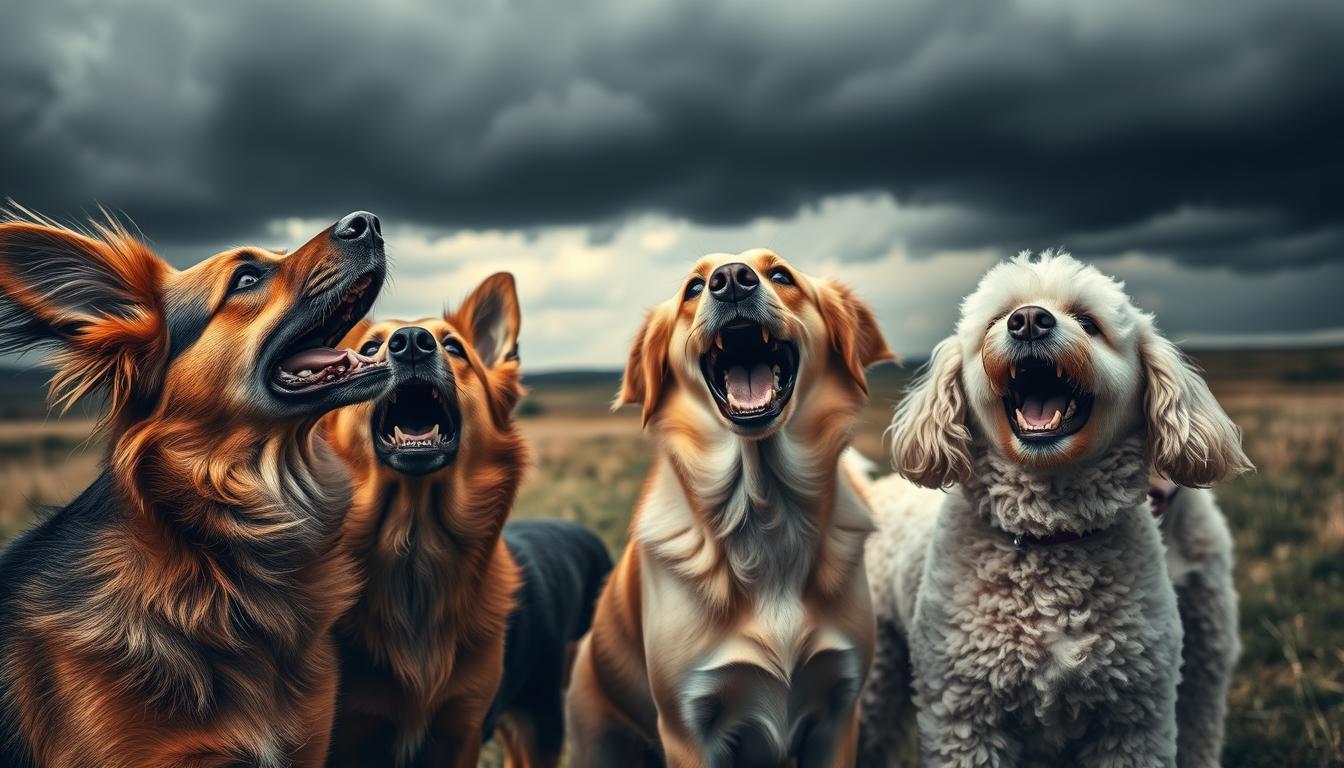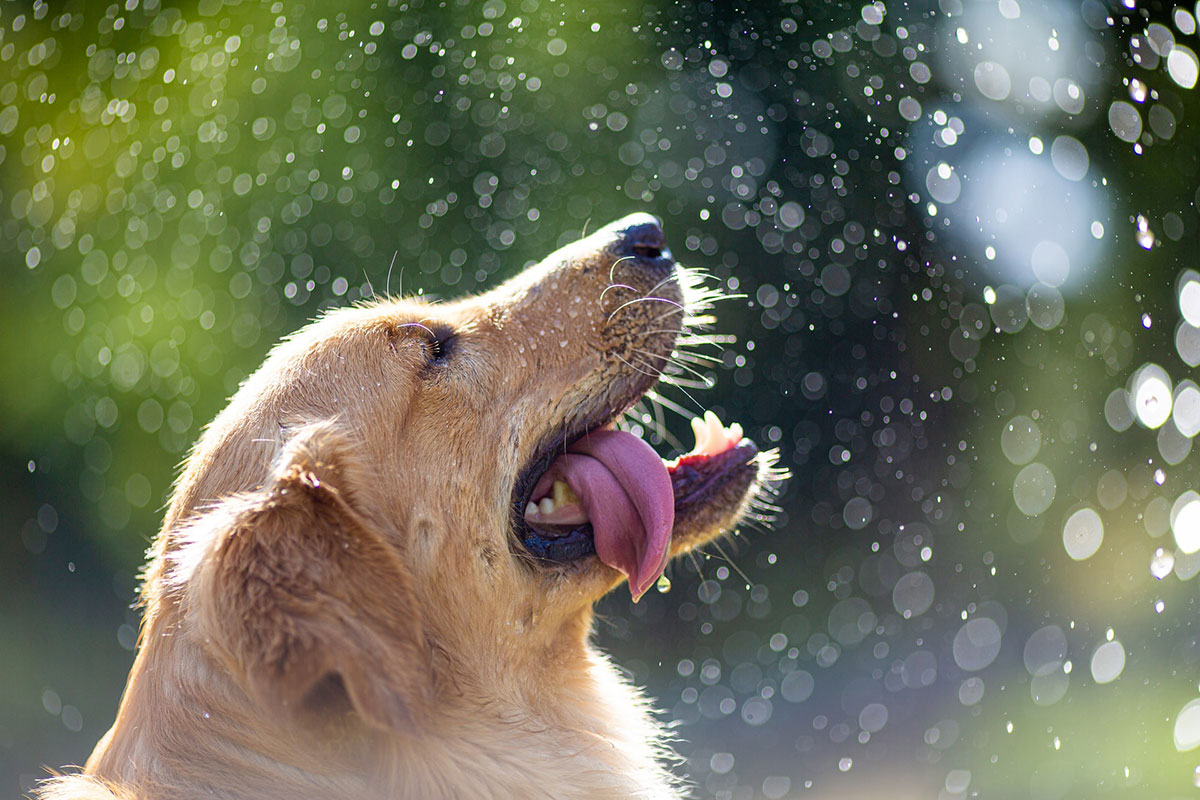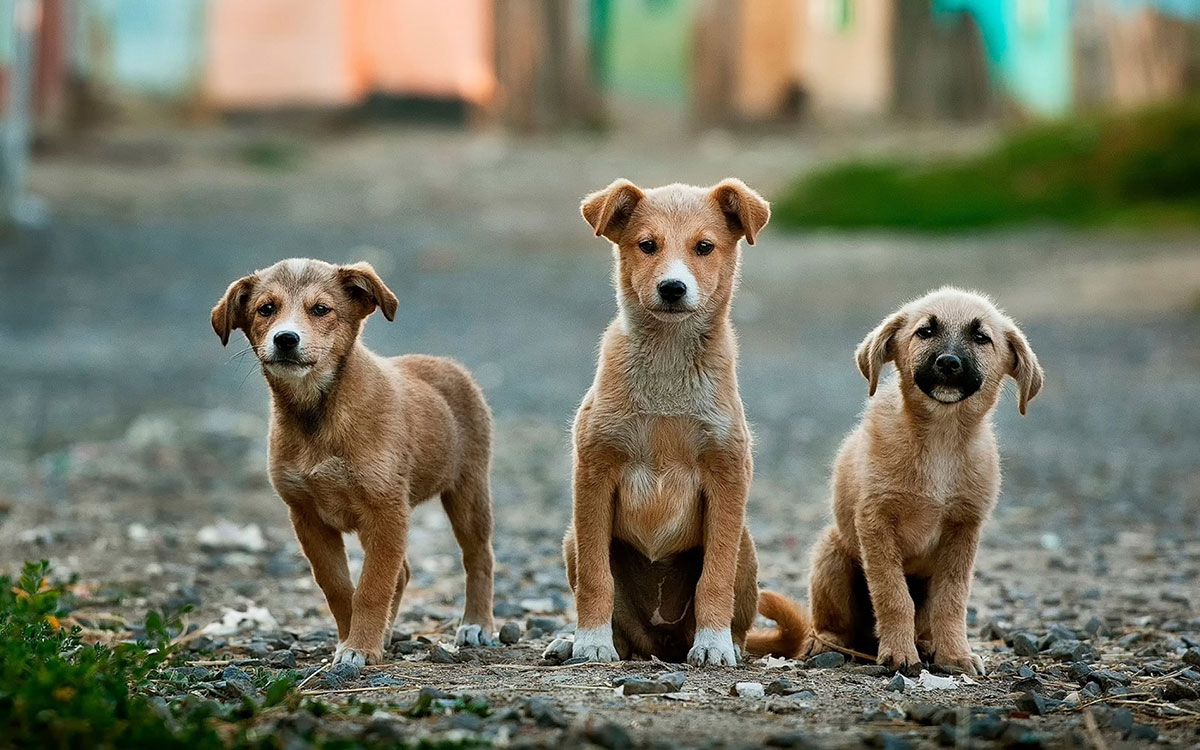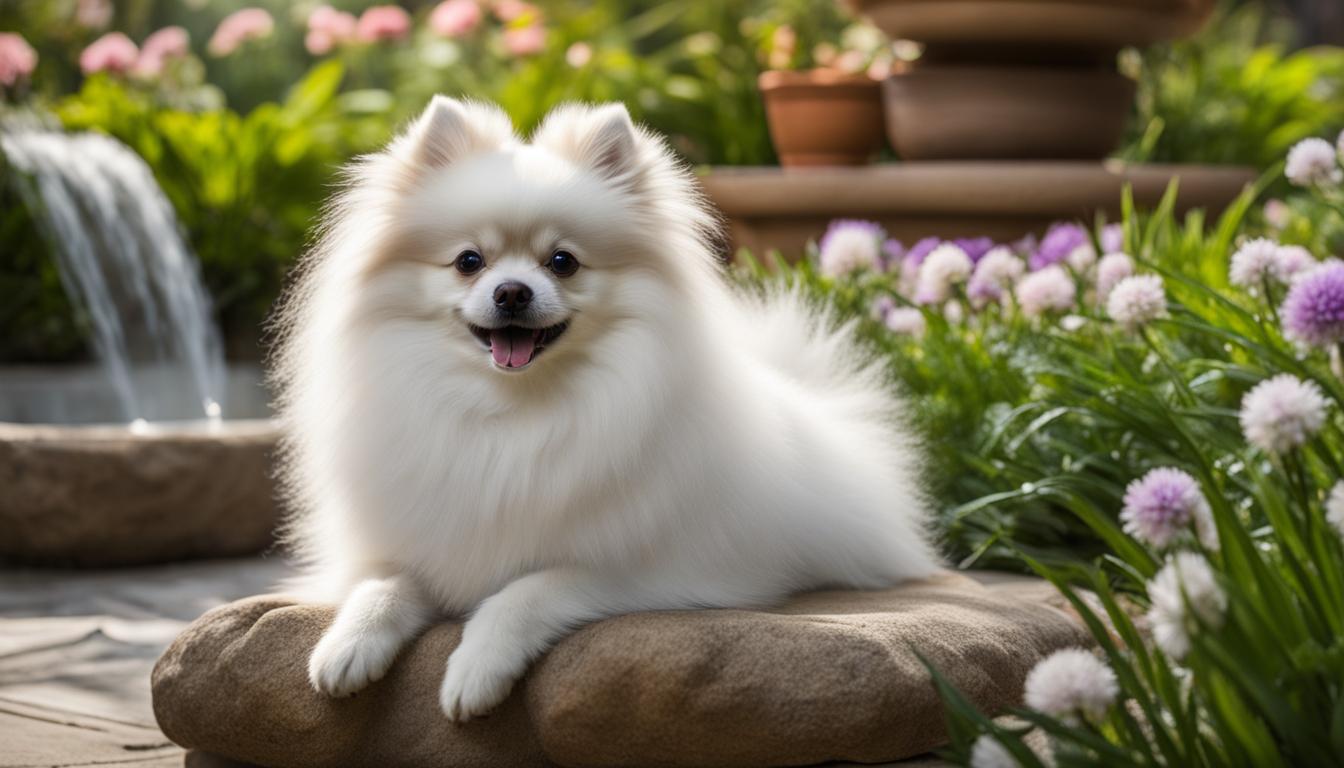Many dog owners notice their pets exhibiting anxiety before a storm. This often shows as excessive barking. It’s not just a coincidence; dogs can sense changes in their environment, like barometric pressure changes.
Dogs can feel the drop in pressure before a storm. This makes them anxious and alerts them to the weather coming.
It’s important for dog owners to understand why their pets act this way. Research from Canine Evolutions shows dogs can pick up on infrasound waves from storms. This can make them act before the storm hits.
By knowing these signs, owners can use calming techniques to help their dogs feel better during storms.
Key Takeaways
- Changes in barometric pressure can trigger anxiety in dogs, leading to barking before storms.
- Creating a safe space can help calm dogs during storms.
- Maintaining a regular routine can provide comfort and reassurance.
- Calming products, such as pheromone diffusers and anxiety wraps, can be effective in reducing storm anxiety.
- Understanding canine behavior and physiological responses can help owners better support their pets.
The Science Behind Dogs’ Storm Sensitivity
Dogs are very sensitive to storms because of their sharp hearing and feeling changes in air pressure. Their keen senses help them detect storms.
Enhanced Hearing Capabilities
Dogs can hear sounds up to 45,000 Hz, while humans can only hear up to 20,000 Hz. This enhanced hearing capability lets them pick up infrasound from storms, which humans can’t hear.
Sensitivity to Air Pressure Changes
Dogs are also very sensitive to changes in barometric pressure. They can feel even small changes in air pressure before a storm. This makes them anxious or restless before the storm hits.
The mix of these factors leads to canine anxiety during storms. Knowing this can help dog owners ease their pets’ storm phobia.
| Factor | Description | Impact on Dogs |
|---|---|---|
| Enhanced Hearing | Ability to hear high frequencies and infrasound | Detection of storm approach |
| Barometric Pressure Sensitivity | Sensitivity to changes in air pressure | Anxiety and restlessness before storms |
| Environmental Changes | Changes in weather and air pressure | Triggering storm phobia |
Understanding the science behind dogs’ storm sensitivity helps owners prepare and calm their pets during storms.
Common Signs of Storm Anxiety in Dogs
It’s important to know when your dog is feeling anxious during storms. Dogs show different behaviors when they’re worried about storms.
Excessive Barking Patterns
Excessive barking is a common sign of storm anxiety in dogs. This barking can be constant and seem unexplained. Some dogs bark more as a storm gets closer, showing their distress.
If your dog is barking a lot, you might find useful tips on how to stop a German Shepherd from barking. These tips can also help other breeds feeling anxious during storms.
Hiding and Seeking Behaviors
Dogs may hide or seek their owners when they’re anxious about a storm. Some hide under beds or in closets. Others look for their owners for comfort.
Understanding these behaviors helps you support your dog better.
Panting and Drooling
Panting and drooling are signs of storm anxiety in dogs. These signs often come with other physical signs like trembling or pacing. Spotting these signs early helps calm your dog.
Trembling and Pacing
Trembling and pacing show a dog’s high anxiety level. Dogs may shake with fear or pace to release energy. Creating a calm space can help ease these symptoms.
| Signs of Storm Anxiety | Description |
|---|---|
| Excessive Barking | Persistent barking with no apparent reason other than storm sensitivity |
| Hiding and Seeking | Dogs hide or seek owners for comfort |
| Panting and Drooling | Physical signs accompanying anxiety |
| Trembling and Pacing | Clear indicators of anxiety, showing fear or restlessness |
Why Dogs Bark Before Storms and Proven Calming Techniques
Dogs barking before storms can be scary. It’s not just random; it’s a sign of their heightened senses and anxiety.
Dogs of different breeds and ages react differently to storms. For example, herding dogs and working breeds have unique traits that affect how they react.
Herding Dogs vs. Working Breeds
Herding dogs, like Border Collies and German Shepherds, are very sensitive to their surroundings. They might be more reactive to weather changes. Working breeds, such as Siberian Huskies, are built for endurance and might handle storm anxiety differently.
Calming Techniques for Herding and Working Breeds:
- Give them a safe space with things they know and love.
- Keep them busy before the storm to take their mind off it.
- Try calming aids like pheromone diffusers.
Small Dogs in Apartments
Small dogs in apartments can get really anxious during storms. Their anxiety is just as strong as bigger dogs, but in different ways.
Calming Techniques for Small Dogs:
| Technique | Description |
|---|---|
| Sound Masking | Use white noise machines to block out storm sounds. |
| Safe Spaces | Make a cozy, storm-safe spot with blankets and toys they love. |
| Owner Interaction | Spend time with your dog doing calming things. |
Puppy vs. Senior Dog Reactions
Puppies and senior dogs have unique needs during storms. Puppies need extra reassurance and training. Senior dogs might need changes in their environment to feel less stressed.
Knowing what your dog needs based on their breed, size, or age is key. Tailor your calming techniques to meet their specific needs. This way, you can help reduce their anxiety and make them feel more comfortable.
Creating a Storm-Safe Space for Your Dog
A storm-safe space can be a cozy haven for your dog, offering comfort and safety. It’s key to lowering your dog’s storm anxiety.
Apartment-Specific Solutions
Apartment dwellers can find a quiet room or spot away from windows for a storm-safe space. Using calming aids like pheromone diffusers or calming music can make it even better.
Basement vs. Interior Room Options
In houses, basements are great because they’re underground and quieter. Or, an interior room without windows, like a closet or bathroom, works well too.
Make the space cozy with your dog’s favorite bedding and toys. Adding a few of their favorite things can really help.
Familiar Scents and Objects
Using familiar scents, like a blanket smelling like you or your dog, can calm them. Some owners also leave an article of clothing with their scent for comfort.
| Feature | Apartment | House |
|---|---|---|
| Location | Quiet room or area away from windows | Basement or interior room without windows |
| Calming Aids | Pheromone diffusers, calming music | Pheromone diffusers, calming music |
| Comfort Items | Familiar bedding, toys, and scents | Familiar bedding, toys, and scents |
“The key to helping your dog feel safe during storms is creating a comfortable and secure environment. This can significantly reduce their anxiety.”
By following these tips, you can make a great storm-safe space. It will help lower your dog’s storm anxiety.
Immediate Calming Techniques During Storms
Storms can be scary for dogs. But, there are ways to calm them down and make them feel safer. It’s important to have a plan ready to soothe your dog when a storm comes.
Massage and Touch Therapy
Massage and touch therapy can be very effective. Gentle petting or massage can calm your dog’s nerves. This physical contact can be comforting and distract them from the storm.
Gentle stroking or rubbing behind the ears or under the chin works well. It’s key to be gentle and calm. Your dog can sense your energy.
Proper Holding Techniques
Some dogs like being held or cradled. Proper holding techniques mean holding them securely but gently. This makes them feel safe and supported, reducing their anxiety.
Games and Toys
Playing games or giving them favorite toys can distract them from the storm. Interactive toys filled with treats can keep them busy and calm.
Training Exercises During Storms
Training exercises during storms can also help. Simple commands or tricks can distract your dog and bring a sense of normalcy.
Staying Calm and Confident
It’s important for dog owners to stay calm and confident during storms. Dogs can sense their owner’s anxiety, making their own fear worse. By staying calm, you can help your dog feel more at ease.
Avoiding Reinforcement of Fear
While comforting your dog is natural, it’s key to avoid reinforcing their fear. Don’t make a big fuss over their anxiety. Instead, act normally and positively reinforce calm behavior.
| Technique | Description | Benefit |
|---|---|---|
| Massage and Touch Therapy | Gentle petting or massage | Soothes nerves, provides comfort |
| Proper Holding Techniques | Holding dog securely but gently | Makes dog feel safe and supported |
| Games and Toys | Engaging in games or with favorite toys | Distracts from storm, reduces anxiety |
| Training Exercises | Simple commands or tricks | Provides normalcy, distracts from storm |
Long-Term Training Strategies for Storm Anxiety
Long-term training is crucial for your dog to handle storm anxiety. A consistent and patient approach can greatly reduce their stress during storms.
Using Storm Sound Recordings
Using storm sound recordings is an effective way to desensitize your dog. Start with low volumes and gradually increase them.
Gradual Exposure Techniques
Gradual exposure techniques slowly introduce your dog to storm sounds. This makes them less reactive over time.
Creating Positive Associations
It’s important to create positive associations with storm sounds. Reward your dog with treats and praise when they stay calm.
Reward-Based Systems
A reward-based system encourages calm behavior. It’s a highly effective way to reduce storm anxiety.
Setting Realistic Timelines
Setting realistic timelines is key. Training progress may be slow, so patience is crucial.
Tracking Progress Effectively
Keep a record of your dog’s progress. This helps you see what works and what needs more work.
| Training Technique | Description | Effectiveness |
|---|---|---|
| Storm Sound Recordings | Desensitize your dog to storm noises | High |
| Gradual Exposure | Slowly introduce storm stimuli | High |
| Positive Associations | Associate storm stimuli with positive outcomes | Medium-High |
| Reward-Based Systems | Reward calm behavior | High |
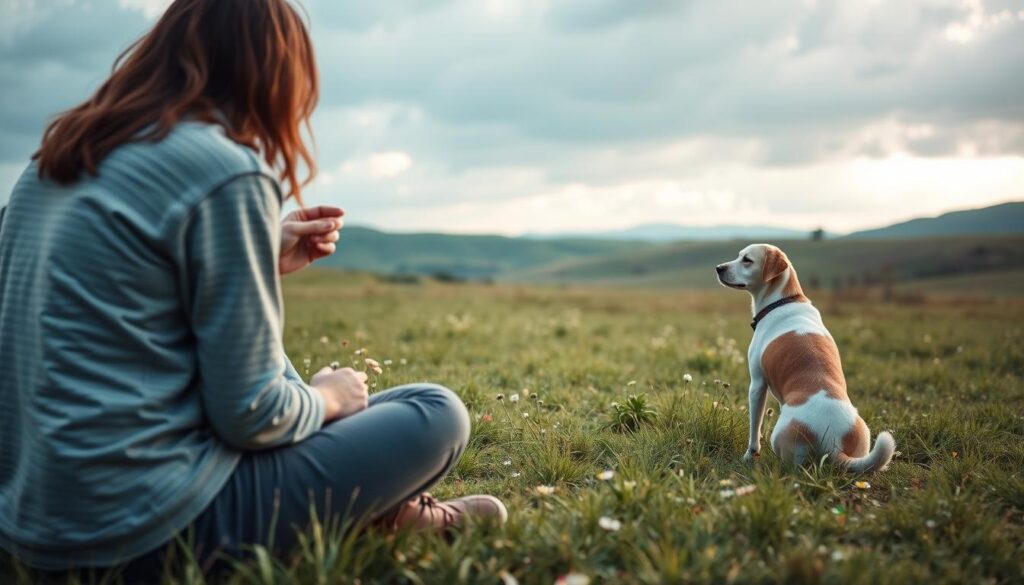
By using these long-term training strategies, you can help your dog feel better during storms. This improves their overall well-being.
Calming Products and Tools
Storms can make dogs anxious. The right calming products and techniques can help. There are many products to choose from, depending on what you and your dog like.
ThunderShirt and Similar Products
ThunderShirt and similar products use gentle pressure to calm dogs. This is based on deep pressure therapy. It has been proven to reduce dog anxiety.
DIY Pressure Wrap Options
If you want something custom, try making a DIY pressure wrap. You can use bandages or cloth to make one.
There are natural and prescription options for calming dogs. Natural choices include pheromone diffusers and calming treats. For more serious cases, prescription meds are available.
| Product Type | Description | Effectiveness |
|---|---|---|
| ThunderShirt | Gentle pressure wrap | High |
| Pheromone Diffusers | Mimics natural calming pheromones | Moderate |
| Calming Treats | Contains natural calming ingredients | Moderate |
Timing for Maximum Effectiveness
Start using calming products before the storm. This helps lower your dog’s stress.
Through a Dog’s Ear and Similar Programs
Calming music and white noise, like “Through a Dog’s Ear,” can mask storm sounds. They create a calm environment for your dog.
Setting Up Sound Barriers
Playing calming music or white noise can block out storm sounds. This greatly reduces your dog’s stress during storms.
Exploring these options can help you find the best calming products for your dog. This way, storms won’t be as stressful for them.
When to Consider Professional Help
For some dogs, storm anxiety can be so intense that they need professional help. While many cases can be managed with certain techniques and products, some dogs may need more specialized help.
Self-Harming Behaviors
If your dog shows self-harming behaviors during storms, like excessive licking or chewing, it’s a clear sign they need professional help. These behaviors can cause physical harm and show a deeper anxiety issue.
Extreme Reactions in Apartments
Dogs in apartments may have extreme reactions to storms because of the small space. If your dog’s reactions are becoming too much, it’s time to seek professional help.
Several professionals can help with storm anxiety in dogs. Veterinary Behaviorists are experts in animal behavior and can guide you on managing storm anxiety. Certified Dog Trainers can also help by creating customized training plans for storm-related fears.
Medication Options
In severe cases, medication options might be considered to help with your dog’s storm anxiety. Talk to a veterinary behaviorist about the potential benefits and risks.
Specialized Training Programs
Some dogs may benefit from specialized training programs for storm anxiety. These programs are tailored to your dog’s specific needs and can be an effective way to manage their anxiety.
| Professional Help Options | Description | Benefits |
|---|---|---|
| Veterinary Behaviorists | Experts in animal behavior | Guidance on managing storm anxiety |
| Certified Dog Trainers | Develop customized training plans | Address storm-related fears |
| Medication Options | Alleviate severe storm anxiety | Consult with a veterinary behaviorist |
| Specialized Training Programs | Tailored to dog’s specific needs | Effective way to manage anxiety |

Real-Life Success Stories
Many dog owners have found ways to help their pets feel better during storms. Their stories offer hope and valuable tips for others.
Managing Noise Complaints from Neighbors
One owner said their dog barked less during storms after using noise-reducing strategies. This helped avoid complaints from neighbors.
Space-Limited Calming Techniques
Creating a cozy, safe space in apartments has helped calm dogs. A relieved owner said,
“My dog now views our apartment as a safe haven during storms,”
Some owners have seen big improvements in their dogs’ storm anxiety in just a few weeks. This is thanks to consistent training and calming products.
Products + Training Success Stories
Using calming products along with training has greatly helped many dogs. An owner shared,
“The combination of training and calming aids was instrumental in treating my dog’s storm phobia.”
Preparing for Future Storms: A Comprehensive Plan
As a dog owner, it’s key to be ready for future storms. This ensures your pet stays comfortable and safe. Knowing why dogs bark before storms helps you tackle their anxiety.
Setting up a storm-safe space is a big step. It could be a cozy room in your home. Here, your dog feels safe and protected from the storm. Using calming techniques like pheromone therapy or treats can also help.
Training your dog to handle storms is another important step. Techniques like desensitization and counterconditioning work well. They help your dog get used to storm sounds and feelings, making them more calm and confident.
With a solid plan, you’re ready for any storm. Your dog will stay safe and calm, thanks to your preparation.

